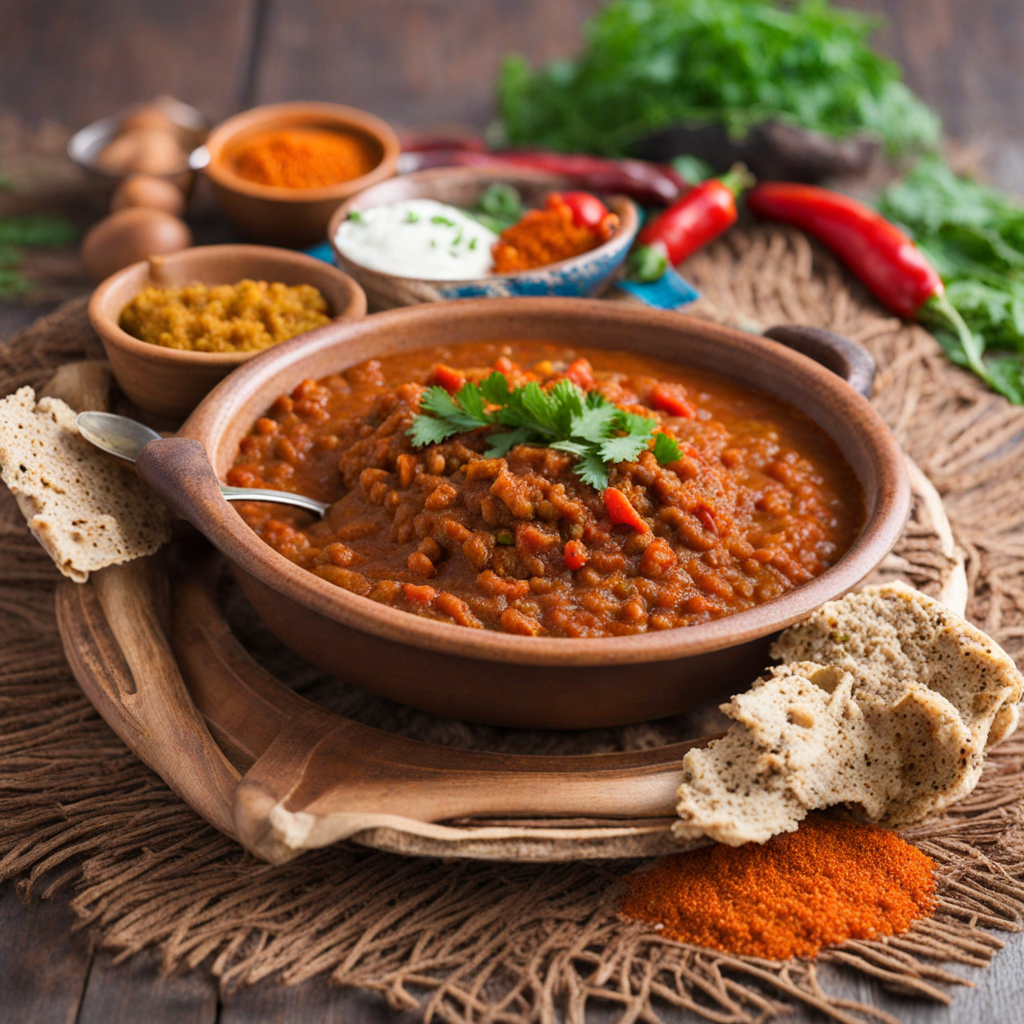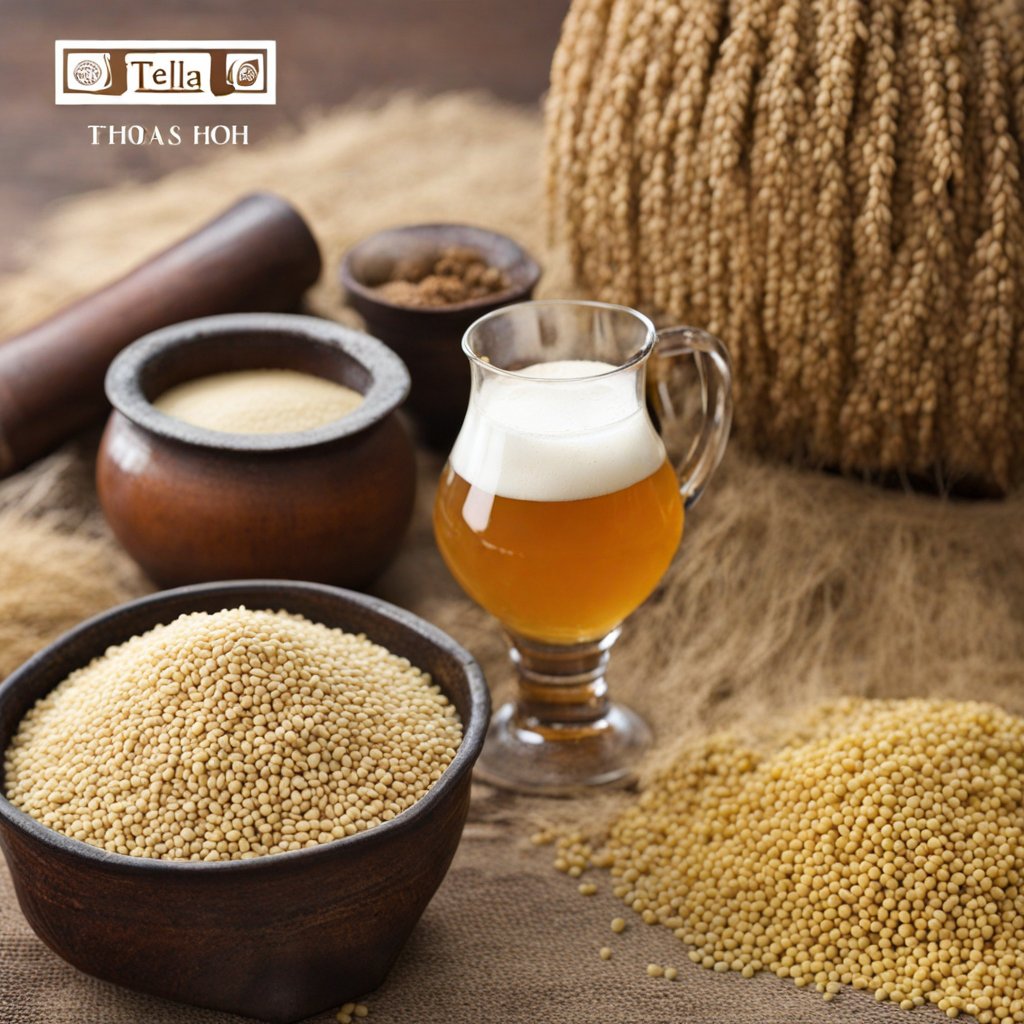Misir Wat
Misir Wat is a traditional Ethiopian dish that boasts a rich, spicy flavor profile, highlighting the country's diverse culinary heritage. At its core, Misir Wat is a lentil stew made from split red lentils that are simmered to perfection. The lentils become tender and absorb the bold spices, creating a dish that is both hearty and satisfying. The vibrant red-orange color of the dish is indicative of the generous use of berbere, a spice blend that includes chili peppers, garlic, ginger, and various other aromatic spices, which gives the stew its characteristic heat and depth of flavor. What sets Misir Wat apart is not only its flavor but also its texture. The lentils break down during the cooking process, resulting in a thick and creamy consistency that clings beautifully to injera, the traditional Ethiopian flatbread. This bread serves as both a utensil and a side dish, allowing you to scoop up the stew and enjoy every bite. The combination of the spicy stew and the slightly sour, spongy injera creates a delightful contrast that enhances the overall experience. Misir Wat is often served as part of a larger Ethiopian meal, which typically features a variety of stews and dishes collectively known as a “messob.” This communal dining style encourages sharing and brings people together around the table, making it a perfect dish for gatherings. Whether you're a seasoned adventurer in the world of flavors or trying Ethiopian cuisine for the first time, Misir Wat offers a unique taste that is both comforting and exciting, inviting you to savor the rich culinary traditions of Ethiopia.
How It Became This Dish
The History and Cultural Significance of ምስር ወጥ (Misir Wat) in Ethiopia #### Introduction Ethiopia is renowned for its rich culinary heritage, characterized by diverse flavors, spices, and unique cooking techniques. One of the most beloved dishes in Ethiopian cuisine is ምስር ወጥ (Misir Wat), a spicy lentil stew that exemplifies the country’s agricultural bounty and its deep-rooted cultural traditions. Misir Wat is not just a meal; it is an embodiment of Ethiopian identity, community, and spirituality. #### Origins of Misir Wat The history of Misir Wat can be traced back to ancient Ethiopia, where agriculture formed the backbone of society. Ethiopia is one of the few places in the world where lentils were domesticated, with archaeological evidence indicating that lentils have been cultivated in the region for thousands of years. The combination of lentils and spices reflects the agricultural practices and the climate of the Horn of Africa, where conditions are ideal for growing these legumes. The name "Misir" derives from the Amharic word for lentils, while "Wat" refers to a thick stew. Lentils are a staple food in Ethiopia, symbolizing sustenance and nourishment. Misir Wat is often prepared with split red lentils, which cook quickly and absorb the flavors of the spices, making them a popular choice for both everyday meals and special occasions. #### Cultural Significance Misir Wat holds significant cultural importance in Ethiopia. It is a staple in the traditional Ethiopian diet, characterized by the use of injera, a sourdough flatbread made from teff flour. The practice of serving stews like Misir Wat on injera not only reflects the communal aspect of Ethiopian dining but also highlights the country's unique culinary tradition. Meals are often shared among family and friends, served on a large platter, and eaten by hand, fostering a sense of community and togetherness. In Ethiopian Orthodox Christianity, Misir Wat is particularly significant during fasting periods, such as Lent. Ethiopians fast for more than half of the year, during which they abstain from animal products. Misir Wat, being vegan, becomes a central dish during these times. The preparation of the stew often includes a careful selection of spices, particularly berbere, a spice blend that embodies the flavors of Ethiopia. This adherence to tradition and the communal aspect of sharing meals enhances the spiritual dimensions of the dish. #### Development Over Time Throughout the centuries, the preparation of Misir Wat has evolved, influenced by various factors, including regional variations, trade, and cultural exchanges. The spice trade, which flourished in the region, introduced new ingredients and flavors to Ethiopian cooking. The incorporation of spices like garlic, ginger, and turmeric not only enhanced the flavor of Misir Wat but also reflected the broader culinary trends of the region and beyond. Regional variations have also emerged, with different areas of Ethiopia adding their own twist to the classic recipe. For example, in the southern regions, Misir Wat might be prepared with additional vegetables, while in the northern parts, it may be served alongside various meat dishes. These variations showcase the adaptability of the dish and its ability to resonate with local tastes and preferences. The modern era has seen a revival of interest in traditional Ethiopian cuisine, both within Ethiopia and globally. As Ethiopian immigrants have settled around the world, they have brought their culinary traditions with them, introducing dishes like Misir Wat to new audiences. Restaurants specializing in Ethiopian cuisine have sprung up in cities worldwide, allowing people to experience the rich flavors and communal dining practices that define Ethiopian culture. In Ethiopia itself, the rise of tourism has led to a renewed appreciation for traditional foods. Culinary festivals and cultural events celebrate dishes like Misir Wat, emphasizing their historical significance and role in contemporary Ethiopian society. Chefs and home cooks alike continue to experiment with traditional recipes, finding innovative ways to present Misir Wat while honoring its roots. #### The Ingredients and Preparation of Misir Wat At the heart of Misir Wat is the humble lentil. The red lentils used in the dish are prized for their quick cooking time and ability to absorb flavors. The preparation typically begins with sautéing onions in oil, followed by the addition of garlic, ginger, and the spice blend berbere. Berbere is a quintessential Ethiopian spice mix, made from a variety of spices, including chili peppers, garlic, ginger, and fenugreek, which contribute to the dish’s signature heat and depth of flavor. Once the aromatics and spices are well combined, the lentils and water are added, allowing them to simmer until tender. The result is a thick, hearty stew that is rich in flavor and nutrition. Misir Wat is often garnished with fresh herbs, such as cilantro, and may be served with a side of cooked greens, providing a balanced and satisfying meal. #### Conclusion In conclusion, Misir Wat is much more than a simple lentil stew; it is a dish steeped in history, culture, and community. From its ancient origins to its modern adaptations, Misir Wat encapsulates the essence of Ethiopian culinary traditions. Its significance during religious observances, its role in fostering community, and its evolution over time reflect the resilience and richness of Ethiopian culture. As more people around the world discover the flavors of Ethiopia, Misir Wat stands as a testament to the country’s heritage, inviting all who partake in it to savor not just a meal, but a rich tapestry of history, identity, and shared humanity. Whether enjoyed at a bustling restaurant in Addis Ababa or served at a family gathering in a distant land, Misir Wat continues to nourish both body and soul, bridging the past with the present and celebrating the enduring legacy of Ethiopian cuisine.
You may like
Discover local flavors from Ethiopia







